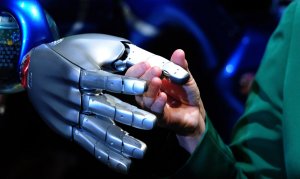Great Cognitive Revolution
22 Dec 2016
Technologies associated with the brain, coming out of the walls of laboratories and begin to penetrate into our lives. This is not an abstract science, and specific preparations, systems and devices. They may feel they can be purchased. Great cognitive revolution is happening before our eyes. In our world becomes more and more devices that are configured on a dialogue with the person carefully watching us and studying us.
Introduction
man sitting in a chair, hung with electrodes.
Think of any number, "- he says scientist in a white coat. After a few seconds on the screen appears the figure five. The device is able to read thoughts. And there is nothing sensational about it.
The device for reading thoughts ...
cord management in the distance ...
Prostheses with which it can be seen without the aid of the eye ...
Drugs make a person smarter and bolder ...

Ten years ago, such scenes belong to the genre of sci-fi fiction. Sometimes there were reports in the press, saying that such a professor is going to create a technology that might help ... The future came quickly. Now you can do without "going" and "possible."
Cognitive: remember the word
The word "nanotechnology" has learned all. Even juniors are ready to Having reported that this piece opens the way for us in the future, that "nano" means ten to the minus ninth and that through this console Russia finally able to get rid of oil dependence.
Now it's time to learn a new word - "cognitive". Cognitio in Latin means knowledge. Cognitive science studies how we perceive the world, how to think, what to look for, how to memorize and so on. On the basis of its discoveries constructed cognitive technologies - devices that take into account our state, attentive to our attention, and even watching the work of our brain.
Now the retina of your eye perceives black characters on a white background. Included are neurons that are pulled out from the memory images are activated knowledge. As a result, you understand the meaning of the article (in any case, we are very hope so). A couple of days will be arguing with a friend about the fate of Russian science and possibly retell a piece of text. Make sure all of this chain - one of the tasks of cognitive science. But not the only one.
Under the banner of cognitive since the sixties of the twentieth century began to unite psychologists, linguists, psychologists, mathematicians, computer scientists, and representatives of other sciences. But right now, the results of their studies are starting to turn into a mass technology. And more importantly, cognitive research merge with other, no less cutting-edge areas.
Cognitive interfaces and virtual reality
The first graphical shell programs have emerged in the 80s, and in just a few years occupied the minds of progressive part of humanity. The graphical interface has revolutionized, to make computers an essential complement to the human brain, because the world is on the computer screen has become similar to the objective world, to work with which our brain is set up.
But in its current form, the graphical interface is obsolete and no touch screen position is not saved. The fact that he does not consider user identity, our state interests and goals - he can not adjust to us and maintain a dialogue, as it should any normal robot from the movie.
Alternatives are available - for example, a pilot interface, which is developing an iconic game designer Peter Molyneux. Instead, the desktop - living in the lap of the virtual nature of the boy Milo, getting to know the user is able to determine his mood's expression, understanding it and ready to run any command or just talk about life (in his virtual world, too, some his own life with its events ).
Interfaces of the near future will be able to perceive not only verbal, but also the mental command. Today, these interfaces allow you to interact with the computer and communicate on the network paralyzed people, able to move only his eyes. For a wireless computer control and other devices enough camera, tracking the direction of gaze.
And of course, in the near future interface, as it sounds banal, it becomes three-dimensional. Why, by the way, still has not become? In the cognitive scientists has unexpected answer: to work with three-dimensional displays is very difficult for our brain, occurs quickly seasick (it is now called "simulator sickness") and a strong psychological discomfort. Virtual reality - Cognitive technology based on the use of visual illusion, to deception of our senses. But when leaving the third dimension we have been able to deceive the only part of the mechanisms of visual perception, there is a mismatch of the conflict brainwave programs, and the user hangs up. You head after "Avatar" did not hurt? With the current 3D technology, we will not rest, and tired in the three-dimensional "home theater", which is about to begin the conquest of the market - there is not enough cognitive solutions.
Crowned picture of a bright future interface for interaction with your own brain, allowing, among other things, to strengthen and weaken the desires and emotions. We are waiting for the temptation, in comparison with which any drugs seem child's play! It would not turn into the legendary rat, the owner of the world's first brain control panel, which is all the stings and stings on the pedal, enabling her center of pleasure, until she died from exhaustion. And yet, people should take up the challenge to move on.
Neuroeconomics and neuro-politics
On the basis of conventional image processing with webcams already today it is possible to analyze human emotions. For example, policy advocates, and the system logs and analyzes its facial expressions, and tells us whether the speaker is lying, or simply disingenuous and what his real feelings about what has been said.
Further - more, the smart thing to learn to look to us directly into the brain. A typical experiment of the rapidly growing field of neuromarketing: the subject show commercials, but this time his brain scanning equipment magnetic resonance imaging (fMRI). The reaction of the test on the rollers as a whole or for individual objects and scenes judged by a special color areas of the brain, indicative of their increased or decreased activity. Experimenters are not interested, like the subject or not advertising, it is important how the brain responds. On assurances neyromarketologov, the technology allows to design advertisements so that they cause the most positive reactions of people and how they can be firmly imprinted in the subconscious.
For example, the study of cognitive scientists at Bonn University, titled "What do men want?". The subjects were shown three groups of cars - sports, such as Ferrari, middle class and economy class cars. It turns out that different cars react different structures of the brain. Structures associated with spontaneous emotion sharply intensified in all subjects men, when they showed a sports car, and the other two classes of cars, on the contrary, caused their braking. For the cars easier reacted structures associated with the conscious control of behavior, "reasonable choice." I wonder what brain structures we react to produce a domestic car industry ...
So far, however, fMRI - a very expensive method and apparatus are extremely cumbersome, but remember how to look and how many computers cost a few decades ago. Methods of monitoring the activity of the brain is also developing rapidly, and after 10 years counterparts fMRI can be used in everyday life.
NBIC time
Several years ago the US National Science Foundation, under the auspices of which being the lion's share of research in the United States, released a report that predicts the development of science in the next 50 years. The report was named NBIC, or in Russian NBIC. Abbreviation is not too harmonious, but that it is becoming a major trend in the coming decades.
"H" - a nanotechnology, "B" - biotechnology, "I" - information technology and, finally, the "K" - cognitive technologies. Half a century ago, these four areas are on the sidelines of world science. In any case, it seemed not as important as nuclear physics or chemistry of polymers.
The revolution of information technology began in the '60s, the rapid progress of biotechnology turned in the 90s, in zero, we all ears buzz about nanotechnology, and are now beginning to develop rapidly cognitive technologies.
Now with "nano", "bio", "info-" and "Cogno-" bind future. Thus all four areas should be developed in a dense bundle. Take, for example, information technology. The capacity of electronic media is growing at a breakneck pace. Soon you will be able to get out of the box with the disc "Movie" sign on which all the movies ever made will be recorded by Hollywood. But you'll need some sort of device that allows you to find the information you need, without spending time and nerves. And this is a cognitive technology.
One of the first in Russia fashionable theme of "NBIC" grabbed the Kurchatov Institute, known for its ability to convert new ideas into solid science infusion of public money.
7 cognitive technologies that will change the world
Many developments in the field of cognitive technologies invented in Russian institutes and universities, and then sold on the domestic enterprises. We have identified seven major trends in this area - those without which a few years it will be impossible to imagine life. All of them already exist in the form of actual technologies and some even reached the normal production.
1. Get smart: Cogne-tropic drugs (nootropics)
What is. Our thinking - is a chain of chemical reactions. It means for intelligence and the emotions can be influenced by chemical substances. For centuries, this was done with the help of alcohol, drugs and other muck. But now science is ready to offer a set of effective and relatively safe medications like.
Positive effect on the processes underlying perception, analysis of information, learning and memory ... "- that describe the drug Semax its creators from the Institute of Molecular Genetics, Russian Academy of Sciences. Development began in the 70s by order of the Ministry of Defence. Now semax drop can be found in any drugstore.
The drug does not "change the mind", it only improves cognitive function, brings them back to normal. In order to bury itself in the nose of the substance do not necessarily suffer any disease
healthy people can take semaks to stimulate memory and performance. "
Following Semax appeared on the shelves of pharmacies Selank, which helps to cope with stress, removes the fear and anxiety.
We continue to work on new drugs acting on the central nervous system, cognitive functions. They will have a different structure - shared with "PP" Academician Nikolai Myasoedov who directed these works. - But while the development in the early stages, and that it will turn out, we can not say.
There are also more extravagant ideas. For example, Professor Konstantin Anokhin Institute of Normal Physiology RAMS will release a substance capable of erasing unpleasant memories. And this is not a utopia, a drug already tested on animals.
What will happen. At first, people using smart doping, will benefit over more conservative opponents every GMO and other innovations. Then the society will get used to this "cosmetics for the mind." Tablets that affect thinking, will take everyone - teachers, office workers, police officers. It will be as normal as drinking vitamins today.
2. Transparent Head: neuroimaging
What is. Transparent mouse brain, which Russian scientists have demonstrated Dmitry Medvedev - one of the most vivid symbols neuroimaging, saying, look, thinking is becoming more open to science, and to the authorities.
Our brains for many years was regarded as a "black box." Behavioral psychologists taught: you can only learn what the input, - words, images and other incentives, and that at the outlet, - retaliatory words and actions. What happens inside the skull remained a mystery. Now, there are computerized tomography, magnetic resonance imaging, positron emission tomography, magnetic resonance spectroscopy, and so on - a lot of modern technologies to literally see the work of our consciousness.
This is necessary not only to doctors. In recent years, the fashion is such a thing as neuromarketing. Man shows the options for the new package of oatmeal and watching how the brain reacts to it, which zones are activated and which remain calm.
What will happen. "Peeking" in the brain become traditional procedure in different areas. This will engage and sociologists, and educators and criminologists. Their work will be much more effective. However, recall unsuited dystopia feared not only ordinary people.
3. Artificial senses
What is. Technology can replace the eyes, ears, nose and other organs. In many laboratories of the world is the development of visual prostheses that will make even sighted totally blind people. You do not need to use the eye and the optic nerve - a signal with a miniature camera goes directly to the cerebral cortex, which is implanted a special chip.
On a theoretical level, all the technology is already understood and tested on rats and cats. Now we are talking about the technical details.
That is, the scientists checked how the electrodes will behave in the brain tissue, whether the inflammation, whether corrosion will occur.
What will happen. It is expected that mass cure the blind and the deaf will begin in a few years. A few decades implanted electronics can be more sensitive than living bodies. After all, we see only in a narrow wavelength range, and survey the space of only 180 degrees. The visual prosthesis is theoretically capable of transmitting the image to the brain and in the ultraviolet and infrared, and X-ray ranges. And you can see, not only in front, but the back, side and top.
4. Know the state: cognitive assistants
What is. Good secretary always takes into account the state of his boss - is irritated, tired, or good-natured. But to replace the busty blonde in short skirts is already underway electronics. Various systems are beginning to help the person to monitor their activities.
Begin with a simple - to sleep. A small company "NeurOK", created on the basis of the Institute of Radio Engineering and Electronics, Russian Academy of Sciences, released the driver awake sensors. At least one-third of traffic accidents is due to the fact that the man had fallen asleep for a moment and lost control of the situation. Condition prior to falling asleep can be identified by brain rhythms, eye movements, especially of speech or the electrical conductivity of the skin. The man has not yet had time to fall asleep, and the unit is already beeping and flashing.
And again this is not some kind of experimental design, such devices are already in the cockpits of several thousand Russian locomotives. Soon to begin mass production of such devices for car drivers.
What will happen. Sensors driver wakefulness may enter into a massive turnover in the coming years. It is possible that the Europeans, who are concerned about their safety, require all drivers to install such devices, and then the market of such devices will be in the hundreds of millions. Gradually learn to cognitive systems to help us in all - to drive, to learn foreign languages, to cope with temper tantrums. We will quietly listen to the recommendations of smart organizer:
5. Brain Bashers: Brain-Machine Interfaces
What is. Mind reading is becoming a scientific commonplace. Conduct experiments, published articles, thesis defended. Systems to directly transmit signals from the brain to the computer,
However, not only the brains of a computer controlled, but also vice versa.
What will happen. In two or three years in the computer can be a supermarket to buy a device that allows you to play shooter rpg using the power of thought. And sooner or later it becomes available mental control any device, and such a trifle as computers and mobile phones, move from our pockets directly into the brain connected to the Great Network.
6. Iron thought: intelligent robots
What is. The robot can easily depict the movement of the waiter, janitor or collector circuits. It is much harder to teach him to imitate the way of thinking. Scientists and engineers are trying to make mechanical devices more and more like a person, not only in appearance but also intellectually. Robots must be taught to see (recognize objects, to determine their location), hear (detect spoken language), thinking (quick decisions).
In Russia, too, such developments are under way. By the way, in the area of "intellectual stuffing" we are not so far behind the Americans and Japanese, both in the field of mechanics.
The basis is the emotional behavior of living people - their speech, intonation, facial expressions, behavior. The resulting model algoritmized and converted into program code. As a result, the computer screen is already talking painted men, able and joke, and angry.
What will happen. On "Revolution robots" speak for half a century. It never happened. Instead, there is an evolution: robots penetrate into our lives rather slowly, but surely. For example, according to the forecast of TechCast, by 2022, intelligent robots, sensory environment environment, decision-makers, students, will be used in 30% of households and organizations. And soon for someone robot may be more sensitive companion than a colleague or neighbor in the stairwell.
Analysts will not be needed: automatic analysis of texts
What is. Mankind produces every second, millions of pages of text. And the world is ruled not the one who owns the information and someone who knows how to handle it and filter. Computer systems are not only able to lay out the documents on the shelves, but also try to understand their content.
For example, the company Cognitive Technologies was created by the Institute of System Analysis, RAS. Its profile - creation and implementation of management systems in enterprises. The main feature is considered intelligent analysis of business information: "We have created a new form of description of the document, whose main elements are the so-called semantic units ... In fact, this approach is nothing more than an attempt to abstract the implementation of the mechanism of thinking in artificial intelligence systems." Similar systems are already in place in a very reputable companies such as the "Norilsk Nickel".
Also work everywhere electronic translators or handwriting and voice recognition systems. And if we ask Google find something containing the word "cognition" and "technology", then the system will be wise enough to give us an article on cognitive technologies, despite the fact that the word "cognitive" in them never used.
Ten years from analysts, reporters, translators and many other professionals have to compete with cars. Systems themselves will compare the texts and numbers, and then draw conclusions. And there is a risk that people will lose this fight. Already, the computer is able to digest thousands of pages per second, and when he learns more and analyze this information, people will be in difficulty.

 Cart
Cart





